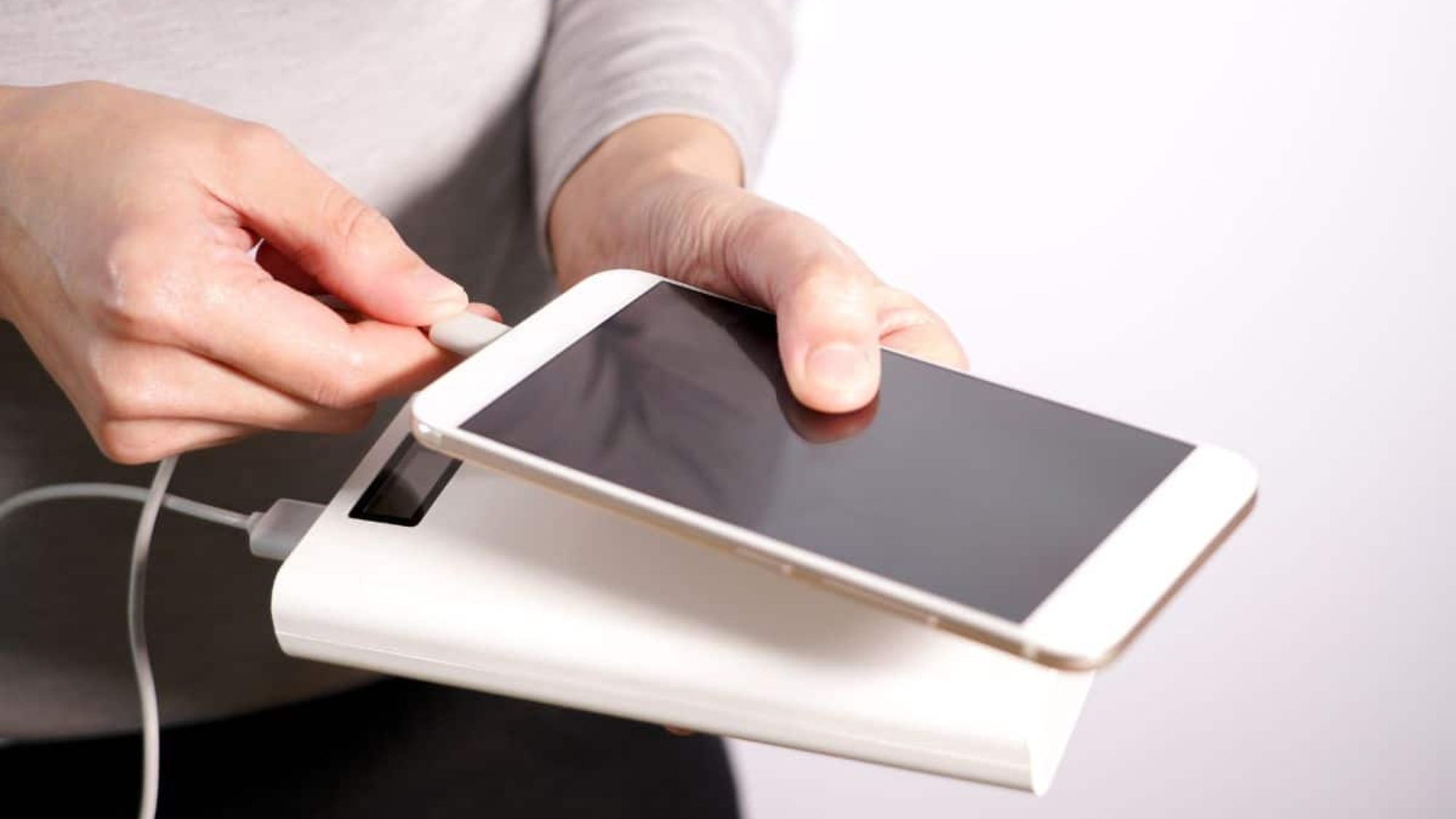Low battery and no charger around? No matter if you are traveling, outside, or experiencing a power outage, there are simple ways how to charge your phone without a charger.
Your phone’s battery stores power to keep it running. Even without a charger, you can still charge it through a power bank, laptop, solar charger, or another phone.
In this guide, we’ll share 7 simple and reliable ways to charge your phone when you don’t have a charger. You’ll find out which methods work best, which are quickest, and how to keep your phone safe while charging.
What You’ll Learn:
- Best ways to charge your phone without a charger
- Fastest and most convenient charging options
- How to charge using a laptop, car, or solar power
- Important safety tips to protect battery life
Some methods charge quickly, while others take longer but are great in emergencies. No matter where you are, this guide will help you keep your phone powered up anytime, anywhere!
How Phone Charging Works (Quick Explanation)
Normally, a regular charger provides 5V of power, while fast chargers use higher power levels (9V or 12V) to speed things up. But if you’re wondering how to charge your phone without a charger, there are other ways, like using a power bank, plugging into a laptop, wireless charging, or even solar power. If you’re specifically looking for how to charge your phone without a charger iPhone, you can try MagSafe wireless charging or sharing power from another phone. Charging also creates heat, and too much heat can weaken your battery over time, so it’s best to keep your phone cool while charging to make the battery last longer.
7 Easy Ways to Charge Your Phone Without a Charger
Phone battery running low and no charger around? Don’t worry! There are simple and handy ways to keep your phone going. These 7 easy ways will help you charge your phone without a regular charge.
1. Use a Power Bank – The Best Option
Why It Works:
- Fast and easy—just plug it in!
- Works anywhere—great for travel, emergencies, and power outages.
- Can charge your phone multiple times, depending on the size of the power bank.
How to Use It:
- Connect your phone to the power bank using a USB cable.
- Use the fast-charging port (marked 2.1A or 3A) for quicker charging.
- Turn on Airplane Mode to save battery and charge faster.
Pro Tip: Always keep a power bank in your bag or car for emergencies.
Recommended Power Bank: Anker PowerCore 20,000mAh
2. Charge Using a Laptop or PC (USB Method)
Why It Works:
- A simple backup option if no wall plug is available.
- Works with a USB cable (Micro-USB, USB-C, or Lightning).
How to Use It:
- Plug your phone into your laptop’s USB port.
- If your laptop is plugged in, charging will be a bit faster.
- Use a USB 3.0 port (blue one) for better charging speed.
Pro Tip: If your laptop has many USB ports, use the most powerful one for faster charging.
3. Try Wireless Charging (If Your Phone Supports It)
Why It Works:
- No cables are needed—just place your phone on a charging pad.
- Available in Starbucks, airports, and hotels.
How to Use It:
- Find a wireless charging station (in malls, cafes, airports).
- Place your phone on the charging pad.
- If it doesn’t start charging then adjust your phone’s position.
Pro Tip: Remove thick phone cases because they block wireless charging.
4. Use Reverse Charging to Share Power Between Phones
Why It Works:
- You can transfer battery power from another phone using a cable or wireless charging.
How to Use It:
For Wireless Power Sharing:
- Go to Settings > Battery > Wireless Power Sharing.
- Place your phone back-to-back with another phone.
For USB-C to USB-C Charging:
- Connect both phones with a USB-C to USB-C cable.
- The donor phone will send power to your phone.
Pro Tip: The other phone must have at least 50% battery for this to work well.
5. Charge Your Phone Using Solar Power (Best for Outdoors)
Why It Works:
- Great for camping, hiking, or emergencies.
- Uses sunlight because there is no need for electricity.
How to Use It:
- Place your solar charger in direct sunlight.
- Connect your phone using a USB cable.
- Wait because this method is slower but works!
Pro Tip: Get a solar charger with a built-in battery to store power.
6. Use a Car Battery or USB Adapter
Why It Works:
- Perfect for road trips—charges your phone while you drive.
How to Use It:
- Plug a USB car charger into your car’s cigarette lighter.
- Use a fast-charging USB cable.
- Start your car or switch to accessory mode to begin charging.
Pro Tip: Always try to keep a USB car charger in your glove box because it will help you in emergencies.
7. Public Charging Station (Be Careful of Hacking!)
Why It Works:
- Many airports, malls, libraries, and cafes have free charging ports.
- A quick way to boost your battery while traveling.
How to Stay Safe
- Avoid unknown USB ports because they may be unsafe.
- Always use a USB data blocker to protect your phone from hackers.
- If possible always try to use your own charging cable instead of a public one.
Pro Tip: Turn on Airplane Mode while charging to charge faster.
Best USB Data Blocker: PortaPow USB Data Blocker
How to Charge Your Phone Without a Charger: Fastest & Easiest Charging Options Compared
Not all charging methods are the same. Some are fast and reliable, perfect for daily use, while others might be slower but lifesaving in an emergency. This table breaks down the best options based on speed, convenience, and when to use them.
|
Charging Method |
Speed |
Convenience |
Best For |
|
Power Bank |
Fast |
Very easy |
Travel, emergencies |
|
Laptop USB Port |
Slow |
Easy |
Work, no wall charger |
|
Wireless Charging |
Medium |
Convenient |
Home, public spaces |
|
Reverse Charging |
Slow |
Limited |
Emergency use |
|
Solar Charger |
Very Slow |
Needs sunlight |
Outdoor camping |
|
Car Charger |
Medium |
Reliable |
Road trips, long drives |
|
Public Charging |
Medium |
Easy but risky |
Travel, emergencies |
Simple Safety Tips for Charging Without a Charger
- Tip 1: If your phone gets hot while charging, unplug it and let it cool before charging again.
- Tip 2: Always use a good-quality power bank that stops charging when your phone is full to avoid battery damage.
- Tip 3: Don’t keep your phone plugged into a car charger all night because it can drain your car’s battery.
- Tip 4: Always use strong, well-made charging cables to avoid overheating and slow charging.
- Tip 5: Be careful when using public USB ports because hackers can steal your data. So always use your own charger or a USB safety plug.
- Tip 6: Turn on Airplane Mode while charging to make your phone charge faster.
- Tip 7: When using solar charging, place the panel in direct sunlight for the best result.
Final Thoughts
A dead phone can’t ruin your day anymore because now you know how to charge your phone without a charger by using a power bank, laptop, solar charger, or even another phone.
The best method depends on where you are. Power banks and car chargers work fast, while solar chargers and public charging stations are good backups. Always use good-quality cables and be careful with public USB ports to keep your phone and data safe.
Be prepared and stay connected. Keep a backup charging option with you, and you’ll never worry about a low battery again.
For more simple tech tips and repair solutions, visit TechyCompany and stay ahead of the game!
FAQs: How to Charge Your Phone Without a Charger
If there’s no electricity then you can charge your phone using a power bank, solar charger, or a hand-crank generator. If you have access to a car battery, use a car charger to power up your phone.
If your phone isn’t charging follow these steps:
- check the charging port for dust,
- try a different cable or adapter, or restart your phone.
If the battery is empty, leave it plugged in for 10-15 minutes before turning it on. If nothing works, wireless charging or using another phone to share power might help.
If you don’t have a Samsung charger then you can use a USB-C to USB-C cable to charge from another device, like a laptop, power bank, or another phone. Wireless charging is another option (Samsung phone supports it).
If you don’t have a Type-C charger, you can use a USB-C to USB-C cable to charge from a laptop, tablet, or another phone that supports power-sharing. Many power banks and wireless charging pads also work with Type-C devices.
If both phones support reverse charging, place them back-to-back to share power wirelessly. If wireless power-sharing isn’t available, use a USB-C to USB-C cable (for Android) or a Lightning to USB-C cable (for iPhones) to transfer battery from one phone to another.
If you don’t have your iPhone charger, you’ve got a few options!
- If your iPhone supports wireless charging then just place it on a charging pad.
- You can also use reverse charging from another phone or plug your iPhone into a laptop or PC with a USB cable.
- Another good option is to use a power bank or car charger when you’re on the move.


Add a Comment